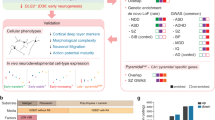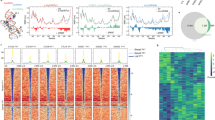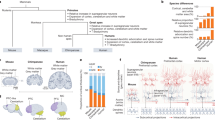Abstract
As neuronal differentiation of embryonic stem cells (ESCs) recapitulates embryonic neurogenesis, disturbances of this process may model developmental neurotoxicity (DNT). To identify the relevant steps of in vitro neurodevelopment, we implemented a differentiation protocol yielding neurons with desired electrophysiological properties. Results from focussed transcriptional profiling suggested that detection of non-cytotoxic developmental disturbances triggered by toxicants such as retinoic acid (RA) or cyclopamine was possible. Therefore, a broad transcriptional profile of the 20-day differentiation process was obtained. Cluster analysis of expression kinetics, and bioinformatic identification of overrepresented gene ontologies revealed waves of regulation relevant for DNT testing. We further explored the concept of superimposed waves as descriptor of ordered, but overlapping biological processes. The initial wave of transcripts indicated reorganization of chromatin and epigenetic changes. Then, a transient upregulation of genes involved in the formation and patterning of neuronal precursors followed. Simultaneously, a long wave of ongoing neuronal differentiation started. This was again superseded towards the end of the process by shorter waves of neuronal maturation that yielded information on specification, extracellular matrix formation, disease-associated genes and the generation of glia. Short exposure to lead during the final differentiation phase, disturbed neuronal maturation. Thus, the wave kinetics and the patterns of neuronal specification define the time windows and end points for examination of DNT.
Similar content being viewed by others
Log in or create a free account to read this content
Gain free access to this article, as well as selected content from this journal and more on nature.com
or
Accession codes
Abbreviations
- CNS:
-
central nervous system
- DNT:
-
developmental neurotoxicity
- DoD:
-
day of differentiation
- ESC:
-
embryonic stem cells
- GO:
-
gene onthology
- mESC:
-
murine embryonic stem cell
- N:
-
gene onthology neuronal differentiation
- NPC:
-
neural precursor cell
- RA:
-
all-trans retinoic acid
- Shh:
-
sonic hedgehog
- GMEM:
-
Glasgow's modified Eagles medium
- FBS:
-
fetal bovine serum
- PFA:
-
paraformaldehyde
- PBS:
-
phosphate-buffered saline
References
Conti L, Cattaneo E . Neural stem cell systems: physiological players or in vitro entities? Nat Rev Neurosci 2010; 11: 176–187.
Gaspard N, Bouschet T, Hourez R, Dimidschstein J, Naeije G, van den Ameele J et al. An intrinsic mechanism of corticogenesis from embryonic stem cells. Nature 2008; 455: 351–357.
Kuegler PB, Zimmer B, Waldmann T, Baudis B, Ilmjarv S, Hescheler J et al. Markers of murine embryonic and neural stem cells, neurons and astrocytes: reference points for developmental neurotoxicity testing. Altex 2010; 27: 17–42.
Barberi T, Klivenyi P, Calingasan NY, Lee H, Kawamata H, Loonam K et al. Neural subtype specification of fertilization and nuclear transfer embryonic stem cells and application in parkinsonian mice. Nat Biotech 2003; 21: 1200–1207.
Götz M, Huttner WB . The cell biology of neurogenesis. Nat Rev Mol Cell Biol 2005; 6: 777–788.
Abranches E, Silva M, Pradier L, Schulz H, Hummel O, Henrique D et al. Neural differentiation of embryonic stem cells in vitro: a road map to neurogenesis in the embryo. PLoS One 2009; 4: e6286.
Leist M, Bremer S, Brundin P, Hescheler J, Kirkeby A, Krause KH et al. The biological and ethical basis of the use of human embryonic stem cells for in vitro test systems or cell therapy. Altex 2008; 25: 163–190.
Strübing C, Ahnert-Hilger G, Shan J, Wiedenmann B, Hescheler J, Wobus AM . Differentiation of pluripotent embryonic stem cells into the neuronal lineage in vitro gives rise to mature inhibitory and excitatory neurons. Mech Dev 1995; 53: 275–287.
Ying QL, Smith AG . Defined conditions for neural commitment and differentiation. Methods Enzymol 2003; 365: 327–341.
Makris SL, Raffaele K, Allen S, Bowers WJ, Hass U, Alleva E et al. A retrospective performance assessment of the developmental neurotoxicity study in support of OECD test guideline 426. Environ Health Perspect 2009; 117: 17–25.
Grandjean P, Landrigan PJ . Developmental neurotoxicity of industrial chemicals. Lancet 2006; 368: 2167–2178.
Bal-Price AK, Hogberg HT, Buzanska L, Lenas P, van Vliet E, Hartung T . In vitro developmental neurotoxicity (DNT) testing: relevant models and endpoints. Neurotoxicology 2009 (in press).
Hansson O, Petersén A, Leist M, Nicotera P, Castilho RF, Brundin P . Transgenic mice expressing a Huntington's disease mutation are resistant to quinolinic acid-induced striatal excitotoxicity. Proc Natl Acad Sci USA 1999; 96: 8727–8732.
Penschuck S, Flagstad P, Didriksen M, Leist M, Michael-Titus AT . Decrease in parvalbumin-expressing neurons in the hippocampus and increased phencyclidine-induced locomotor activity in the rat methylazoxymethanol (MAM) model of schizophrenia. Eur J Neurosci 2006; 23: 279–284.
Rossi AD, Larsson O, Manzo L, Orrenius S, Vahter M, Berggren PO et al. Modifications of Ca2+ signaling by inorganic mercury in PC12 cells. FASEB J 1993; 7: 1507–1514.
Wei Y, Harris T, Childs G . Global gene expression patterns during neural differentiation of P19 embryonic carcinoma cells. Differentiation 2002; 70: 204–219.
Aiba K, Sharov AA, Carter MG, Foroni C, Vescovi AL, Ko MS . Defining a developmental path to neural fate by global expression profiling of mouse embryonic stem cells and adult neural stem/progenitor cells. Stem Cells 2006; 24: 889–895.
Jongen-Relo AL, Leng A, Luber M, Pothuizen HH, Weber L, Feldon J . The prenatal methylazoxymethanol acetate treatment: a neurodevelopmental animal model for schizophrenia? Behav Brain Res 2004; 149: 159–181.
Marx-Stoelting P, Adriaens E, Ahr HJ, Bremer S, Garthoff B, Gelbke HP et al. A review of the implementation of the embryonic stem cell test (EST). The report and recommendations of an ECVAM/ReProTect Workshop. Altern Lab Anim 2009; 37: 313–328.
Rao MS, Jacobson M . Dev Neurobiol. Kluwer Academic/Plenum Publishers: New York, 2005.
Collins FS, Gray GM, Bucher JR . Toxicology: transforming environmental health protection. Science 2008; 319: 906–907.
Leist M, Hartung T, Nicotera P . The dawning of a new age of toxicology. Altex 2008; 25: 103–114.
Irioka T, Watanabe K, Mizusawa H, Mizuseki K, Sasai Y . Distinct effects of caudalizing factors on regional specification of embryonic stem cell-derived neural precursors. Brain Res Dev Brain Res 2005; 154: 63–70.
Ying QL, Wray J, Nichols J, Batlle-Morera L, Doble B, Woodgett J et al. The ground state of embryonic stem cell self-renewal. Nature 2008; 453: 519–523.
Elkabetz Y, Panagiotakos G, Al Shamy G, Socci ND, Tabar V, Studer L . Human ES cell-derived neural rosettes reveal a functionally distinct early neural stem cell stage. Genes Dev 2008; 22: 152–165.
Zhang SC, Wernig M, Duncan ID, Brustle O, Thomson JA . In vitro differentiation of transplantable neural precursors from human embryonic stem cells. Nat Biotechnol 2001; 19: 1129–1133.
Feng L, Hatten ME, Heintz N . Brain lipid-binding protein (BLBP): a novel signaling system in the developing mammalian CNS. Neuron 1994; 12: 895–908.
Battiste J, Helms AW, Kim EJ, Savage TK, Lagace DC, Mandyam CD et al. Ascl1 defines sequentially generated lineage-restricted neuronal and oligodendrocyte precursor cells in the spinal cord. Development 2007; 134: 285–293.
Hartung T, Hoffmann S . Food for thought … on in silico methods in toxicology. Altex 2009; 26: 155–166.
Lee S-H, Lumelsky N, Studer L, Auerbach JM, McKay RD . Efficient generation of midbrain and hindbrain neurons from mouse embryonic stem cells. Nat Biotech 2000; 18: 675–679.
Lund S, Christensen KV, Hedtjarn M, Mortensen AL, Hagberg H, Falsig J et al. The dynamics of the LPS triggered inflammatory response of murine microglia under different culture and in vivo conditions. J Neuroimmunol 2006; 180: 71–87.
Mody M, Cao Y, Cui Z, Tay KY, Shyong A, Shimizu E et al. Genome-wide gene expression profiles of the developing mouse hippocampus. Proc Natl Acad Sci USA 2001; 98: 8862–8867.
Schulz H, Kolde R, Adler P, Aksoy I, Anastassiadis K, Bader M et al. The FunGenES database: a genomics resource for mouse embryonic stem cell differentiation. PLoS One 2009; 4: e6804.
Przyborski SA, Smith S, Wood A . Transcriptional profiling of neuronal differentiation by human embryonal carcinoma stem cells in vitro. Stem Cells 2003; 21: 459–471.
van Dartel DA, Zeijen NJ, de la Fonteyne LJ, van Schooten FJ, Piersma AH . Disentangling cellular proliferation and differentiation in the embryonic stem cell test, and its impact on the experimental protocol. Reprod Toxicol 2009; 28: 254–261.
Suter DM, Tirefort D, Julien S, Krause KH . A Sox1 to Pax6 switch drives neuroectoderm to radial glia progression during differentiation of mouse embryonic stem cells. Stem Cells 2009; 27: 49–58.
Conti L, Pollard SM, Gorba T, Reitano E, Toselli M, Biella G et al. Niche-independent symmetrical self-renewal of a mammalian tissue stem cell. PLoS Biol 2005; 3: e283.
Livak KJ, Schmittgen TD . Analysis of relative gene expression data using real-time quantitative PCR and the 2-[Delta][Delta]CT method. Methods 2001; 25: 402–408.
Reimand J, Kull M, Peterson H, Hansen J, Vilo J . g:Profiler – a web-based toolset for functional profiling of gene lists from large-scale experiments. Nucl Acids Res 2007; 35: W193–W200.
Kim KK, Adelstein RS, Kawamoto S . Identification of neuronal nuclei (NeuN) as Fox-3, a new member of the Fox-1 gene family of splicing factors. J Biol Chem 2009; 284: 31052–31061.
Acknowledgements
The work was supported in part by the Doerenkamp-Zbinden Foundation, the DFG, the EU FP7 project ESNATS (ML, SK), an IRTG1331 fellowship (BZ) and a fellowship from the KoRS-CB (PBK). We are grateful to Giovanni Galizia and Sabine Kreissl for help with the electrophysiological recordings and indebted to Bettina Schimmelpfennig for invaluable experimental support. The monoclonal antibodies Gad-6 developed by DI Gottlieb and SV2 developed by KM Buckley were obtained from the Developmental Studies Hybridoma Bank developed under the auspices of the NICHD and maintained by the University of Iowa, Department of Biology, Iowa City, IA 52242, USA. We thank KH Krause for the CGR8 mESC-line, and J Vilo and S Ilmjärv for help with bioinformatics analysis.
Author information
Authors and Affiliations
Corresponding author
Ethics declarations
Competing interests
The authors declare no conflict of interest.
Additional information
Edited by JC Marine
Supplementary Information accompanies the paper on Cell Death and Differentiation website
Supplementary information
Rights and permissions
About this article
Cite this article
Zimmer, B., Kuegler, P., Baudis, B. et al. Coordinated waves of gene expression during neuronal differentiation of embryonic stem cells as basis for novel approaches to developmental neurotoxicity testing. Cell Death Differ 18, 383–395 (2011). https://doi.org/10.1038/cdd.2010.109
Received:
Revised:
Accepted:
Published:
Issue date:
DOI: https://doi.org/10.1038/cdd.2010.109
Keywords
This article is cited by
-
Time and space-resolved quantification of plasma membrane sialylation for measurements of cell function and neurotoxicity
Archives of Toxicology (2020)
-
Major changes of cell function and toxicant sensitivity in cultured cells undergoing mild, quasi-natural genetic drift
Archives of Toxicology (2018)
-
In vitro acute and developmental neurotoxicity screening: an overview of cellular platforms and high-throughput technical possibilities
Archives of Toxicology (2017)
-
Impairment of human neural crest cell migration by prolonged exposure to interferon-beta
Archives of Toxicology (2017)
-
Fingerprinting of neurotoxic compounds using a mouse embryonic stem cell dual luminescence reporter assay
Archives of Toxicology (2017)



